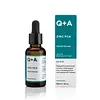What's inside
What's inside
 Key Ingredients
Key Ingredients

 Benefits
Benefits

 Concerns
Concerns

 Ingredients Side-by-side
Ingredients Side-by-side

Water
Skin ConditioningPropylene Glycol
HumectantHydroxyethyl Urea
HumectantGlycerin
HumectantBetaine
HumectantGlyceryl Polymethacrylate
Beta-Glucan
Skin ConditioningCollagen
MoisturisingAloe Barbadensis Leaf Extract
EmollientRetinol
Skin ConditioningPanthenol
Skin ConditioningSodium Hyaluronate
HumectantEthylhexylglycerin
Skin ConditioningXanthan Gum
EmulsifyingPhenoxyethanol
PreservativeWater
Skin ConditioningPropylene Glycol
HumectantLactobacillus/Ganoderma Lucidum Extract/Lentinus Edodes Extract Ferment Filtrate
Skin ConditioningBetaine
HumectantPentylene Glycol
Skin ConditioningZinc PCA
HumectantLactobacillus Ferment
Skin ConditioningLonicera Caprifolium Extract
AstringentLonicera Japonica Callus Extract
Skin ProtectingLactic Acid
BufferingGlyceryl Caprylate
EmollientBiosaccharide Gum-1
HumectantCollagen
MoisturisingGlycerin
HumectantLeuconostoc/Radish Root Ferment Filtrate
AntimicrobialSodium Levulinate
Skin ConditioningSodium Anisate
AntimicrobialSodium Gluconate
Skin ConditioningXanthan Gum
EmulsifyingWater, Propylene Glycol, Lactobacillus/Ganoderma Lucidum Extract/Lentinus Edodes Extract Ferment Filtrate, Betaine, Pentylene Glycol, Zinc PCA, Lactobacillus Ferment, Lonicera Caprifolium Extract, Lonicera Japonica Callus Extract, Lactic Acid, Glyceryl Caprylate, Biosaccharide Gum-1, Collagen, Glycerin, Leuconostoc/Radish Root Ferment Filtrate, Sodium Levulinate, Sodium Anisate, Sodium Gluconate, Xanthan Gum
 Reviews
Reviews

Ingredients Explained
These ingredients are found in both products.
Ingredients higher up in an ingredient list are typically present in a larger amount.
Betaine is a common humectant (a substance that promotes retention of moisture). It's known to be gentle on the skin and can help balance hydration.
This ingredient is best for improving hydration and soothing irritated skin. Studies also show it helps even out skin tone.
Fun fact: Betaine is naturally created in the skin and body. The kind found within cosmetic products can be either plant-derived or synthetic.
Another name for betaine is trimethylglycine.
Learn more about BetaineCollagen is the most abundant type of structural protein found in your body. It is an effective skin moisturizer.
There is no conclusive proof that collagen is used by skin when applied topically. However, it is a great humectant that hydrates skin. Hydrated skin is associated with increased elasticity and a decrease in the appearance of wrinkles. It is also essential for maintaining a healthy skin barrier.
Biologically, collagen is responsible for keeping skin firm and youthful. Collagen is comprised mostly of glycine, proline, and hydroxypoline. These are amino acids.
Collagen will not increase sun sensitivity, but you should always wear sunscreen during the day.
Learn more about hydrolyzed collagen here.
Learn more about CollagenGlycerin is already naturally found in your skin. It helps moisturize and protect your skin.
A study from 2016 found glycerin to be more effective as a humectant than AHAs and hyaluronic acid.
As a humectant, it helps the skin stay hydrated by pulling moisture to your skin. The low molecular weight of glycerin allows it to pull moisture into the deeper layers of your skin.
Hydrated skin improves your skin barrier; Your skin barrier helps protect against irritants and bacteria.
Glycerin has also been found to have antimicrobial and antiviral properties. Due to these properties, glycerin is often used in wound and burn treatments.
In cosmetics, glycerin is usually derived from plants such as soybean or palm. However, it can also be sourced from animals, such as tallow or animal fat.
This ingredient is organic, colorless, odorless, and non-toxic.
Glycerin is the name for this ingredient in American English. British English uses Glycerol/Glycerine.
Learn more about GlycerinPropylene Glycol is an odorless, colorless liquid. As a humectant, it helps skin retain moisture. It also aids in delivering active ingredients.
Another role of this ingredient is preventing a product from melting or freezing. Propylene glycol also adds antimicrobrial properties to a product, elongating product lifespan.
This ingredient is considered an organic alcohol and commonly added into both cosmetics and foods.
Those with sensitive skin or conditions may develop a rash when using this ingredient.
Learn more about Propylene GlycolWater. It's the most common cosmetic ingredient of all. You'll usually see it at the top of ingredient lists, meaning that it makes up the largest part of the product.
So why is it so popular? Water most often acts as a solvent - this means that it helps dissolve other ingredients into the formulation.
You'll also recognize water as that liquid we all need to stay alive. If you see this, drink a glass of water. Stay hydrated!
Learn more about WaterXanthan gum is used as a stabilizer and thickener within cosmetic products. It helps give products a sticky, thick feeling - preventing them from being too runny.
On the technical side of things, xanthan gum is a polysaccharide - a combination consisting of multiple sugar molecules bonded together.
Xanthan gum is a pretty common and great ingredient. It is a natural, non-toxic, non-irritating ingredient that is also commonly used in food products.
Learn more about Xanthan Gum